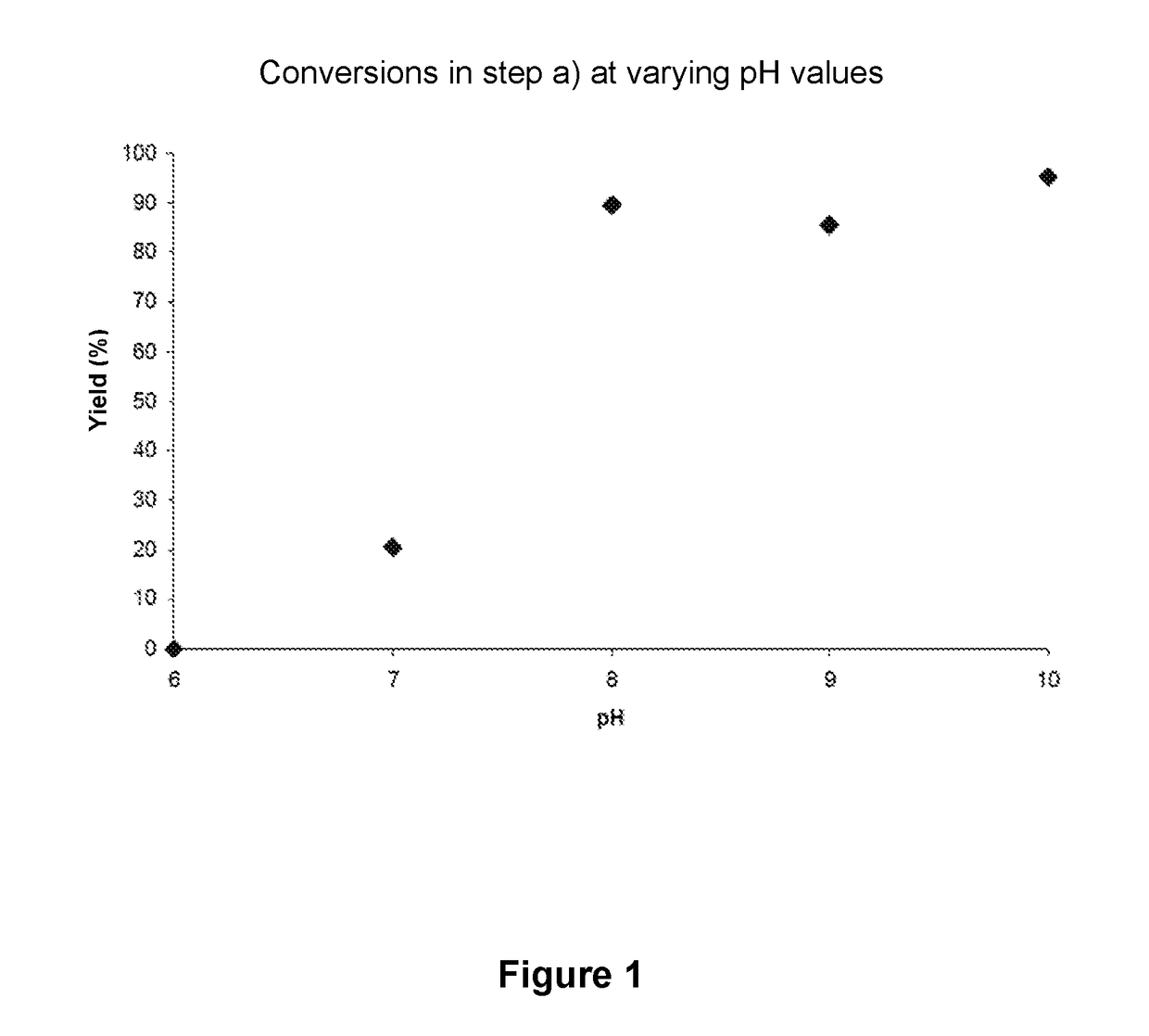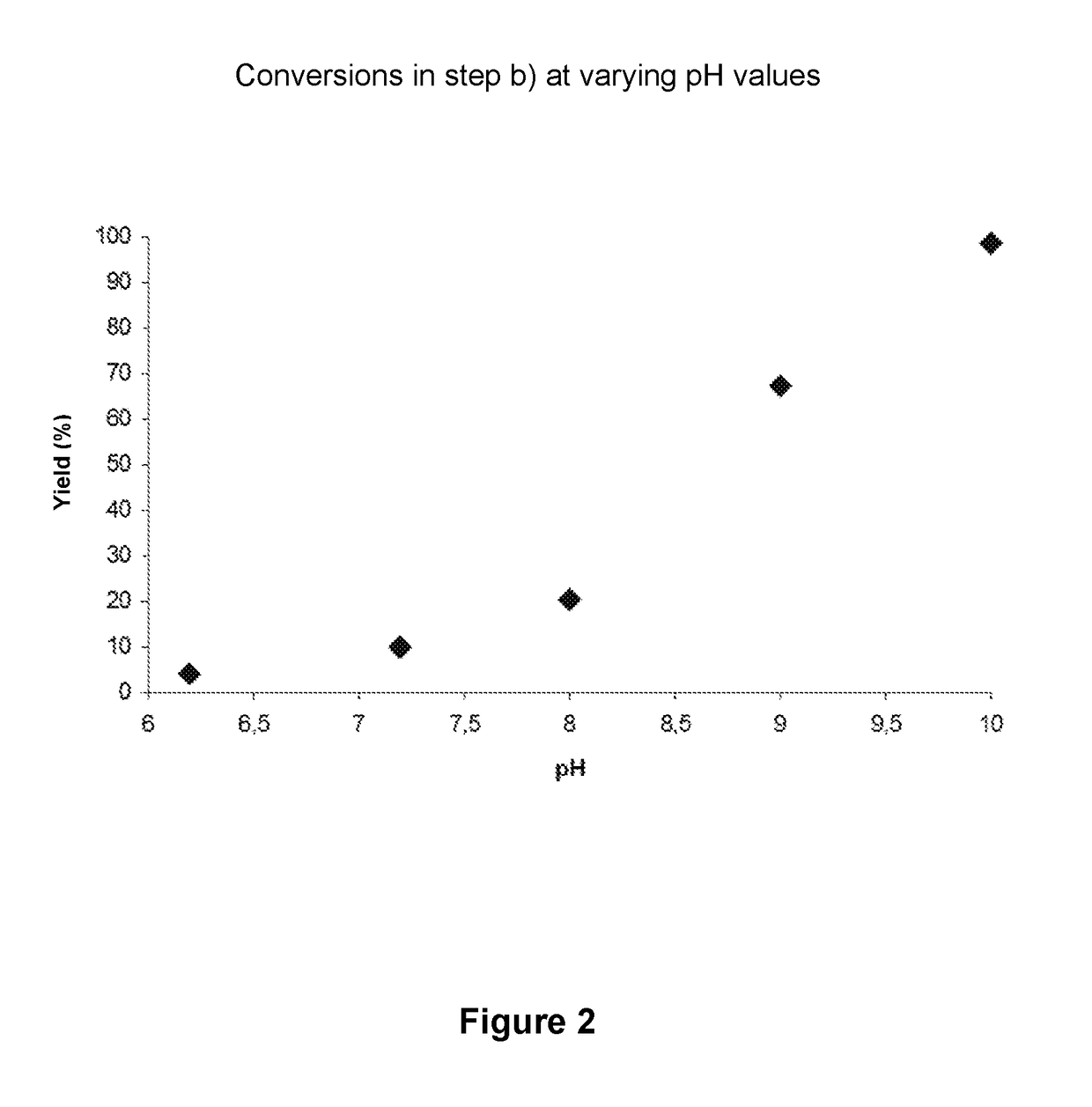METHOD FOR PREPARING p-VINYL PHENOLS
a technology of pvinyl phenol and phenol derivative, which is applied in the field of preparing pvinyl phenol, can solve the problems of low pro-ductivities of this process, inability to perform both strategies on phenol derivatives, and limited reaction to this substrate, so as to increase the overall reaction yield
- Summary
- Abstract
- Description
- Claims
- Application Information
AI Technical Summary
Benefits of technology
Problems solved by technology
Method used
Image
Examples
synthetic example 1
[0038]Preparation of the TPL as a Cell-Free Extract of Citrobacter freundii M379V
[0039]E. coli clones containing the M379V TPL plasmid were grown in LB media that had been prepared by sterilizing a solution (1 L) of the following components in five 1 L Erlenmeyer flasks: tryptone (10 g / L), NaCl (5 g / L), and yeast extract (5 g / L). A pre-culture was prepared by inoculating 100 mL LB media containing ampicillin (100 mg / L). The pre-culture was shaken overnight at 120 rpm and 37° C. Then, the flasks containing ampicillin (100 mg / L) were inoculated with the pre-culture, yielding an initial OD600 of 0.05. Subsequently, the cultures were shaken at 120 rpm and 30° C. until an OD600 of 0.4 to 0.6 was reached. Protein expression was induced using IPTG (0.5 mM final concentration), and cultures were shaken for 2 h at 20° C. and 120 rpm. Finally, the cells were harvested by centrifugation (8000 rpm, 20 min), washed with potassium phosphate buffer (10 mM, pH 7), resuspended in KPi buffer (50 mM, ...
synthetic example 2
[0040]Preparation of the TAL of Rhodobacter sphaeroides as a Whole-Cell Catalyst
[0041]E. coli clones containing the TAL plasmid were grown in LB media that had been prepared by sterilizing a solution (1 L) of the following components in five 1 L Erlenmeyer flasks: tryptone (10 g / L), NaCl (5 g / L), and yeast extract (5 g / L). A pre-culture was prepared by inoculating 100 mL LB media containing kanamycin (50 mg / L). The pre-culture was shaken overnight at 120 rpm and 37° C. Then, the flasks containing kanamycin (50 mg / L) were inoculated with the pre-culture, yielding an initial OD600 of 0.05. Subsequently, the cultures were shaken at 120 rpm and 37° C. until an OD600 of 0.5 to 0.7 was reached. Protein expression was induced using IPTG (0.5 mM final concentration), and cultures were shaken for 24 h at 20° C. and 120 rpm. Finally, the cells were harvested by centrifugation (8000 rpm, 20 min), washed with potassium phosphate buffer (10 mM, pH 8), shock frozen in liquid nitrogen and lyophili...
synthetic example 3
[0042]Production of the FAD of Enterobacter sp. as an E. coli Whole-Cell Catalyst
[0043]E. coli clones containing the FAD plasmid were grown in LB media that had been prepared by sterilizing a solution (1 L) of the following components in five 1 L Erlenmeyer flasks: tryptone (10 g / L), NaCl (5 g / L), and yeast extract (5 g / L). A pre-culture was prepared by inoculating 100 mL LB media containing kanamycin (50 mg / L). The pre-culture was shaken overnight at 120 rpm and 37° C. Then, the flasks containing kanamycin (50 mg / L) were inoculated with the pre-culture, yielding an initial OD600 of 0.05. Subsequently, the cultures were shaken at 120 rpm and 37° C. until an OD600 of 0.5 to 0.7 was reached. Protein expression was induced with IPTG (0.5 mM final concentration), and cultures were shaken for 24 h at 20° C. and 120 rpm. Finally, the cells were harvested by centrifugation (8000 rpm, 20 min), washed with potassium phosphate buffer (10 mM, pH 8), shock frozen in liquid nitrogen and lyophili...
PUM
| Property | Measurement | Unit |
|---|---|---|
| Fraction | aaaaa | aaaaa |
Abstract
Description
Claims
Application Information
 Login to View More
Login to View More - R&D
- Intellectual Property
- Life Sciences
- Materials
- Tech Scout
- Unparalleled Data Quality
- Higher Quality Content
- 60% Fewer Hallucinations
Browse by: Latest US Patents, China's latest patents, Technical Efficacy Thesaurus, Application Domain, Technology Topic, Popular Technical Reports.
© 2025 PatSnap. All rights reserved.Legal|Privacy policy|Modern Slavery Act Transparency Statement|Sitemap|About US| Contact US: help@patsnap.com



